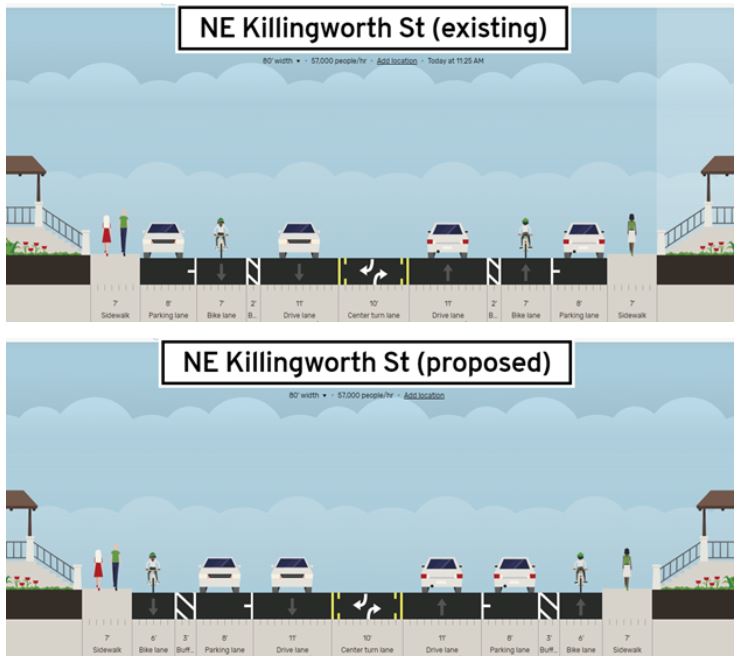
The difference between the existing and proposed changes to NE Killingsworth St.
Courtesy: City of Portland
Long-needed improvements are coming to Portland’s Cully neighborhood. But the exact nature of those changes has changed after the city leaders heard from cyclists of color in the Cully neighborhood.
Engineers had been planning to put bike lanes between parked cars and traffic along Northeast Killingworth Street. But advocates with the groups Andando en Bicicletas y Caminando and the Community Cycling Center wanted the bike lanes to run next to the curb instead. That way parked cars would create a barrier between bicyclists and traffic.
Portland Bureau of Transportation spokesman Dylan Rivera said city leaders heard those concerns and changes are being made.
“We don’t often hear from … communities of color about biking … so we’re really encouraged to see this outreach and conversation,” said Rivera.
“We’re looking forward to continuing the relationship and seeing what the possibilities are.”
Portland City Commissioner Jo Ann Hardesty had asked the city’s transportation department to further engage with the community.
“I am proud that we took a step back to deepen our outreach, part of which was to include more residents who don’t speak English as a first language,” she said in a statement. “Our final survey showed 75% of all area respondents were supportive of PBOT’s final design. I am excited to see the Cully community engaged around a vision for a greener, safer, multi-modal future that benefits everyone no matter how they share the road.”
Marlene Canche, with Andando en Bicicletas y Caminando, said in a statement that she feels safer as a cyclist and a pedestrian. She’s also pleased the city is putting in more marked crosswalks.
“I think a change in driver behavior is also necessary because, in the end, they have to respect the crosswalks in order to truly keep people safe in Cully,” said Canche.
Cully and some other east Portland neighborhoods were originally annexed from Multnomah County, so they were developed under more permissive county rules. In practical terms. that means more recently annexed neighborhoods sometimes don’t have fully improved streets with sidewalks, curbs and full-width pavements.
Cully neighborhood leaders recently asked that Tax Increment Financing not be used for road improvement. People are worried that beautified streets may lead to gentrification. Residents also say they would rather see money spent on other needs, including affordable housing.
But the proposed changes along Northeast Killingsworth are being paid for by Portland’s 10-cent-a-gallon gas tax, not Tax Increment Financing. The changes delayed the project by more than six months but did not increase its $4 million price tag.
The project now enters the design phase. City engineers are developing plans for concrete pedestrian crossing islands, curb ramps, speed reader boards and enhanced lighting.
The resurfacing work is expected to start in 2024. Once resurfacing is complete, Northeast Killingsworth will be freshly striped with the final bike and car lane designs.
The project coincides with the opening of the nearby Hacienda CDC’s new Las Adelitas 141-unit affordable housing development.

